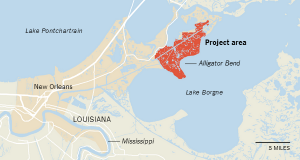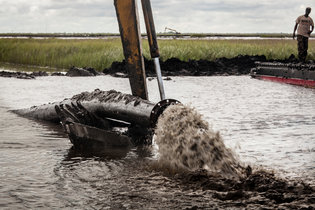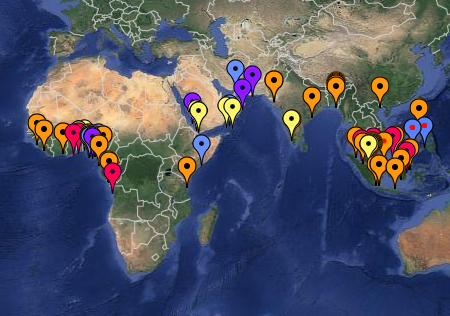creating profit in nature conservation
posted: 12 July 2014
by: John Schwartz
Equity Firm Restores Louisiana Marshland to Earn Credits It Can Sell
ABOARD THE DREDGE BUTCHER, OFF THE LOUISIANA COAST — All day and all night, this ship off a knob of Louisiana at Alligator Bend sucks up silt from the floor of Lake Borgne and pumps it through a half-mile of fat steel pipe. At the other end, a slurry gushes noisily out into what was until recently a stretch of open water. New land is rising here, forming mud flats that will soon be covered with waving spartina grass.
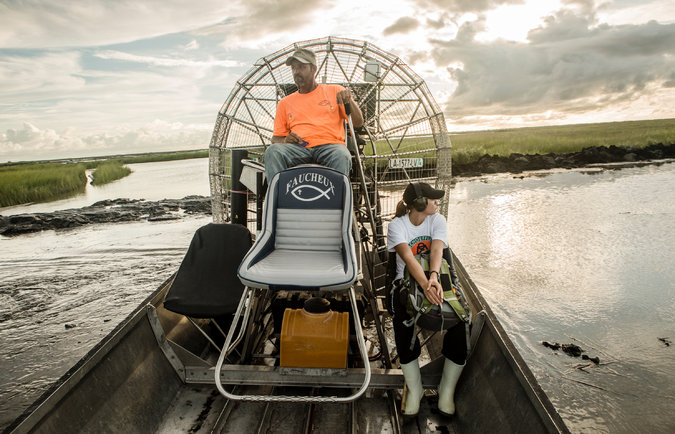
Nick Landry, an airboat captain, and Joy Franchebois, a contractor, surveyed restoration work near Lake Borgne.
This is the unglamorous, mucky — and, to be honest, smelly — work that goes into restoring the fragile marshlands that help protect southern Louisiana from hurricanes and that provide a haven for wildlife.
What is most interesting about this project, however, is who is paying the bills. While the state government has developed a detailed master plan for wetlands restoration in the region, and money has been promised from the federal government and the BP settlement of the 2010 oil spill, this project is getting its funding from a private equity firm. The company, Ecosystem Investment Partners, intends to profit from its good works by selling environmental restoration credits to private developers and government agencies like the Army Corps of Engineers, which need them to offset environmental damage done by their projects.
Such mitigation banks have been allowed for two decades under provisions of the Clean Water Act, but private-sector work tends to be done on a small scale to offset the effect of a single project — say, by placing a frog pond next to the new Walmart — and it tends to be unconnected to any larger environmental purpose. This project is remarkable for its ambition and scope: The company has raised $181 million from investors for this and other projects, and has bought 16,500 acres of this swamp. It could spend, by some estimates, $30 million here.
“They are doing it at a scale that has never been attempted before,” said Val Marmillion, managing director of America’s Wetland Foundation, a nonprofit conservation group that receives some funding from oil companies.
It is essential work. In the last 80 years, coastal Louisiana has lost wetlands roughly the size of Delaware. And this fragile isthmus that Ecosystem Investment Partners is restoring is a “critical land form,” said Ann Redmond, an environmental consultant who helped develop the Louisiana master plan and who has consulted with Ecosystem Investment Partners. This land bridge, which has lost nearly a quarter of its wetlands since 1932, separates Lake Pontchartrain, which borders New Orleans, from Lake Borgne and the open waters of the Gulf of Mexico beyond.
“Anything that can be done to ensure that that land form doesn’t continue to degrade will be important” to protect against storms and to ensure that Lake Pontchartrain does not become too salty, Ms. Redmond said. So this stretch of wetlands, which is alongside Route 90 near what is known as the Chef Menteur Pass, has been targeted for restoration in the Louisiana master plan.
Wetlands loss is caused by a number of factors, including hurricanes, oil and gas exploration, and sea-level rise. Rebuilding it requires some precision: Put in too little dirt, and subsidence — a gradual sinking of the land — and rising oceans will erase it. Put in too much, and you end up with dry land that supports shrubs and scrub — a different environment.
The process of making money out of restoring wetlands is complex, but it comes down to straightforward market principles. A policy developed under the first President George Bush calls for “no net loss” of wetlands, so when developers and government agencies tackle projects that drain or fill wetlands, they need to offset the damage either by restoring an equivalent amount of wetlands or by buying the credits from the restoration work done by others.
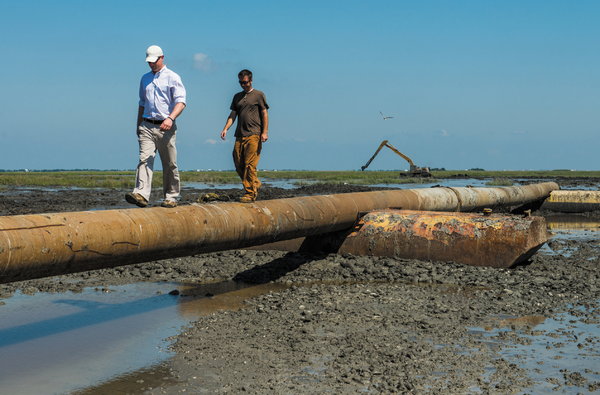
Nick Dilks, left, of Ecosystem Investment Partners, which is funding the work, and Matt Conn, a contractor, inspected a pipeline.
The current phase of the Chef Menteur project, a 508-acre chunk, will ultimately be worth 508 credits under the federal system. Ecosystem Investment Partners can negotiate the value of each credit with the buyers, with the price depending on factors that include the availability of other projects in the same area, the ability of the potential buyer to do its own mitigation projects and how badly the buyer needs the credits.
A federal rule issued in 2008 established a preference for any entity that damages wetlands, including the government, to use mitigation banking over doing the work itself — in part because specialists are more likely to do a better job and to tie the work to broader environmental goals. The preference could encourage private-sector involvement. That is where Ecosystem Investment Partners and similar groups come in, taking on the work and allowing the builders to focus on their projects.
But the field has yet to really take off because, as a recent paper from two Yale-trained researchers put it, the work can be expensive and financially risky, while the size of projects has tended to be too small to attract institutional investors like pension funds and university endowments. Nick Dilks, managing partner of Baltimore-based Ecosystem Investment Partners, declined to say how much the company hoped to earn from the project. However, he said, “We have to generate a competitive return to attract investors.”
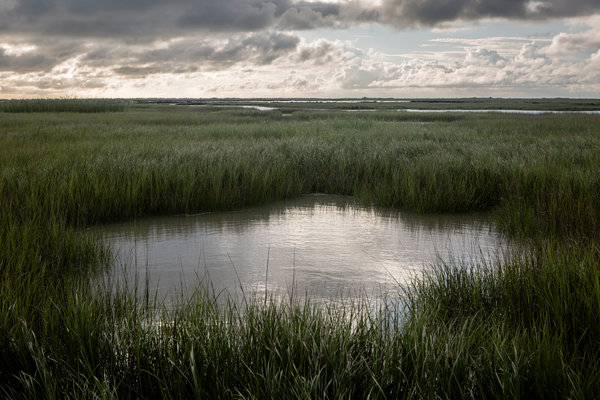
Ecosystem Investment Partners is funding the restoration of Louisiana wetlands and will sell environmental credits to developers.
On a bright morning recently, Mr. Dilks sat at the front of an airboat, the fan-propelled craft that can glide along the brackish water or hop up on the land to slide over marsh grass. Airboats are needed in this place, where the land and water form a blended patchwork.
The slurry that flows out of the pipe deposits 14,250 cubic yards of sediment a day with a rumbling that can be felt through the soles of the shoes of anyone who teeters along the top of the pipe. When the slurry has shells in it, the pipe rattles and pings, making a “Kapew! Kapew!” sound. It is clear that the land is, in fact, rising, though the loose, slippery silt is difficult to build up. “It’s like stacking mayonnaise,” Mr. Dilks said.
Across the way, the long arm of a “marsh buggy” excavator plunges deep in the muck, and the sucking resistance of the marsh as the machine draws out the bucket threatens to tip over the floating platform. But the operator is practiced at his craft, and swings the bucket over to deposit the load along a berm that channels the flow of the water and the deposit of the silt. These marsh buggies have long been used here to create the channels for oil exploration that have torn up the wetlands. “Now it’s the opposite — we’re using them to fill in the channels we made,” said Murray Starkel, managing director of the company.
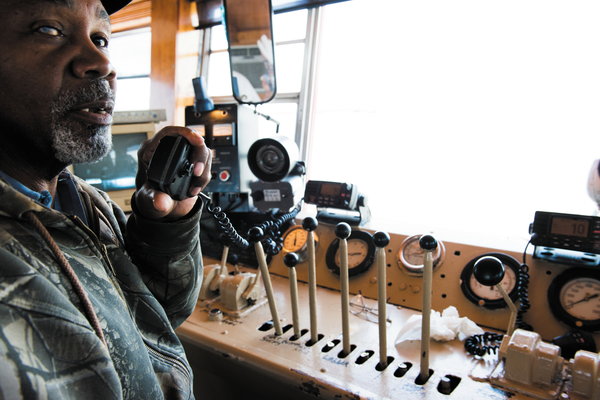
Samuel Mosby operating the dredge Butcher, which draws silt from Lake Borgne to restore the nearby marshland.
As for the smell, Mr. Dilks suggests that the gray-black froth is redolent of “a nice glass of Guinness,” which may mean that he needs to find a better class of pub. The odors include a hint of well-trodden cow pasture after a churning rain.
Who puts money into the risky proposition of restoring swamps for profit? One of the investors is the Lincoln Institute of Land Policy, a nonprofit based in Cambridge, Mass. Katie Lincoln, the chief investment officer for the group’s half-billion-dollar endowment, said she put $10 million into Mr. Dilks’s company not as an environmental do-good project but as an investment that she expected would generate returns. “This is not a charity for us,” she said.
Some of the credits become available when the restorer commits to the project, but the full measure of credits will not be accessible until the project has been completed and has proved successful for five years. Mr. Dilks acknowledged that his company was taking on risk that extended over several years — but said calculating risk was part of what investment fund managers like himself were paid to do. Still, he said, “if you don’t have patient, long-term capital behind you, it’s really hard.”
Mr. Dilks added that he preferred that calculated risk to the alternative. “If we wait 40 years for the money to dribble in for restoration,” he said, “it’ll be gone.”

